
Pool of Radiance is a role-playing video game developed and published by Strategic Simulations, Inc (SSI) in 1988. It was the first adaptation of TSR's Advanced Dungeons & Dragons (AD&D) fantasy role-playing game for home computers, becoming the first episode in a four-part series of D&D computer adventure games. The other games in the "Gold Box" series used the game engine pioneered in Pool of Radiance, as did later D&D titles such as the Neverwinter Nights online game. Pool of Radiance takes place in the Forgotten Realms fantasy setting, with the action centered in and around the port city of Phlan.
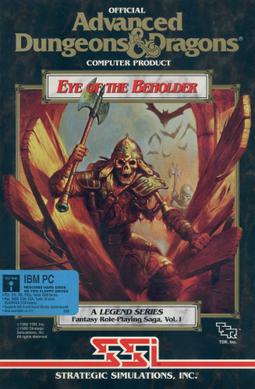
Eye of the Beholder is a role-playing video game for personal computers and video game consoles developed by Westwood Associates. It was published by Strategic Simulations, Inc. in 1991, for the MS-DOS operating system and later ported to the Amiga, the Sega CD and the SNES. The Sega CD version features a soundtrack composed by Yuzo Koshiro and Motohiro Kawashima. A port to the Atari Lynx handheld was developed by NuFX in 1993, but was not released. In 2002, an adaptation of the same name was developed by Pronto Games for the Game Boy Advance.

Curse of the Azure Bonds is a role-playing video game developed and published by Strategic Simulations, Inc (SSI) in 1989. It is the second in a four-part series of Forgotten Realms Advanced Dungeons & Dragons Gold Box adventure computer games, continuing the events after the first part, Pool of Radiance.

Gold Box is a series of role-playing video games produced by SSI from 1988 to 1992. The company acquired a license to produce games based on the Advanced Dungeons & Dragons role-playing game from TSR, Inc. These games shared a common game engine that came to be known as the "Gold Box Engine" after the gold-colored boxes in which most games of the series were sold.

Wizard's Crown is a 1986 top-down role-playing video game published by Strategic Simulations. It was released for the Atari 8-bit, Atari ST, IBM PC compatibles, Apple II, and Commodore 64. A sequel, The Eternal Dagger, was released in 1987.
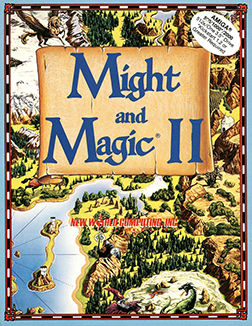
Might and Magic II: Gates to Another World is a role-playing video game developed and published by New World Computing in 1988. It is the sequel to Might and Magic Book One: The Secret of the Inner Sanctum.

Dark Sun: Shattered Lands is a turn-based role-playing video game that takes place in the Dungeons & Dragons campaign setting of Dark Sun. It was developed and published by Strategic Simulations in 1993. It received positive reviews although released initially in an unfinished state. The game had a sequel, Dark Sun: Wake of the Ravager, in 1994. An online MMORPG taking place in the same setting, Dark Sun Online: Crimson Sands, was released in 1996 and hosted on the Total Entertainment Network.

Secret of the Silver Blades is the third in a four-part series of Forgotten Realms Dungeons & Dragons "Gold Box" adventure role-playing video games. The game was released in 1990.
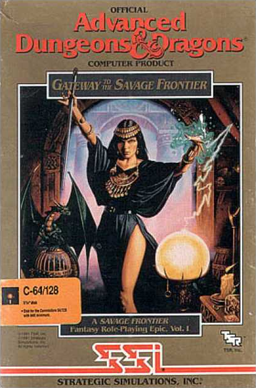
Gateway to the Savage Frontier (1991) is a Gold BoxDungeons & Dragons computer game developed by Beyond Software and published by SSI for the Commodore 64, PC and Amiga personal computers.
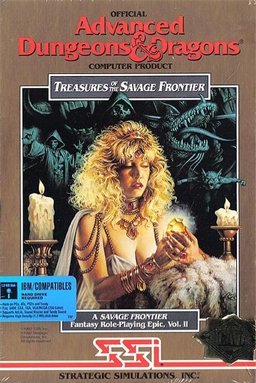
Treasures of the Savage Frontier (1992) is a Gold Box Dungeons & Dragons role-playing video game. It was developed by Beyond Software and published by SSI for the Amiga and DOS.
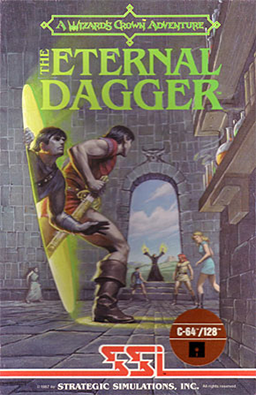
The Eternal Dagger is a top-down role-playing video game published by Strategic Simulations in 1987. It is a sequel to Wizard's Crown from 1986. Demons from another dimension are invading the world, and the only item that can seal the portal is the titular dagger. Players can transfer their characters over from Wizard's Crown, minus whatever magical items they had on them.

Champions of Krynn is role-playing video game, the first in a three-part series of Dragonlance Advanced Dungeons & Dragons "Gold Box" games. The game was released in 1990. The highest graphics setting supported in the DOS version was EGA graphics. It also supported the Adlib sound card and either a mouse or joystick.

Death Knights of Krynn is the second in a three-part series of DragonlanceAdvanced Dungeons & Dragons "Gold Box" role-playing video games, published by Strategic Simulations. The game was released in 1991.

The Dark Queen of Krynn is the third in a three-part series of Dragonlance Advanced Dungeons & Dragons "Gold Box" role-playing video games. The game was released in 1992.

Al-Qadim: The Genie's Curse is an action role-playing game for the personal computer set in the Al-Qadim campaign setting of Advanced Dungeons and Dragons. The game was developed by Cyberlore Studios and published in 1994 by Strategic Simulations (SSI). The game combines role-playing game and adventure with a simplified interface; the player's character is a young corsair trying to clear his family's name, rescue his betrothed and determine who has been freeing genies from their masters.

Shard of Spring is a role-playing video game developed by TX Digital Illusions and published by Strategic Simulations for the Apple II, Commodore 64 and DOS computers in 1986. Shard of Spring tells the story of a group of adventurers hired to retrieve the titular magical item stolen by a power-hungry evil witch. The game was generally well received upon its release and was followed by a sequel titled Demon's Winter in 1988.

Menzoberranzan is a 1994 role-playing video game created by Strategic Simulations (SSI) and DreamForge Intertainment. Menzoberranzan uses the same game engine as SSI's previous game, Ravenloft: Strahd's Possession (1994), and is set in the Advanced Dungeons & Dragons Forgotten Realms campaign setting.

Realms of Darkness is a fantasy video game developed by Strategic Simulations and released in 1986. It was developed for the Apple II and Commodore 64.
Pool of Radiance is a series of role-playing video games set in the Forgotten Realms campaign settings of Dungeons & Dragons; it was the first Dungeons & Dragons video game series to be based on the Advanced Dungeons & Dragons rules.
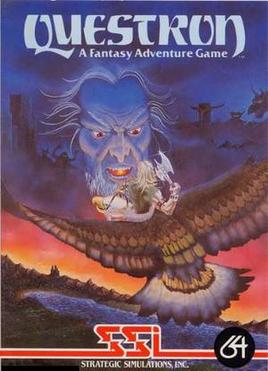
Questron is a 1984 game from Strategic Simulations, the first fantasy title from a company known for computer wargames. It was written by Charles Dougherty and Gerald Wieczorek and released for the Apple II, Atari 8-bit family, and Commodore 64. A sequel, Questron II, was released in 1988.



















